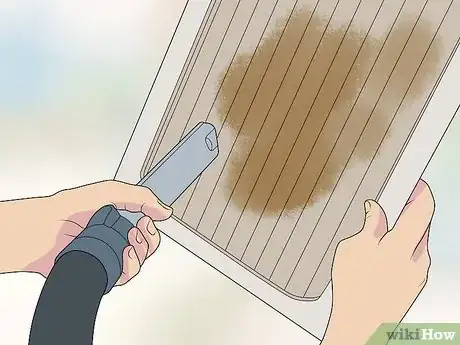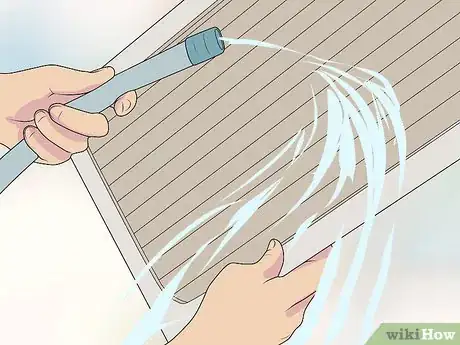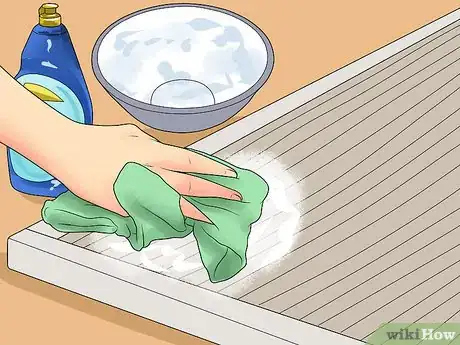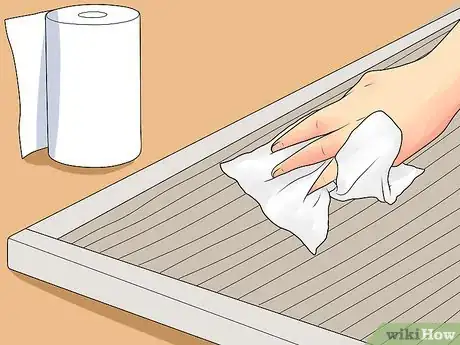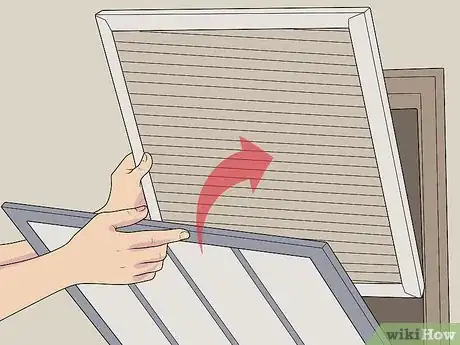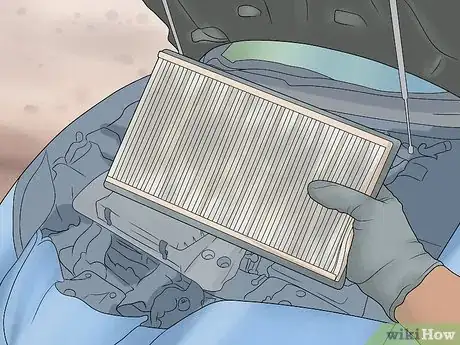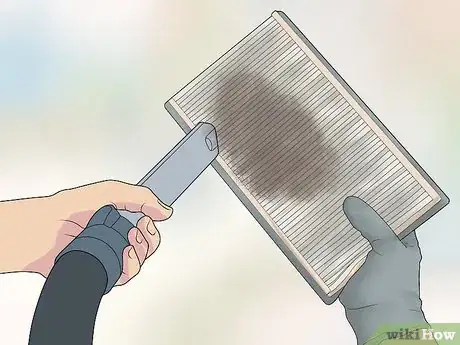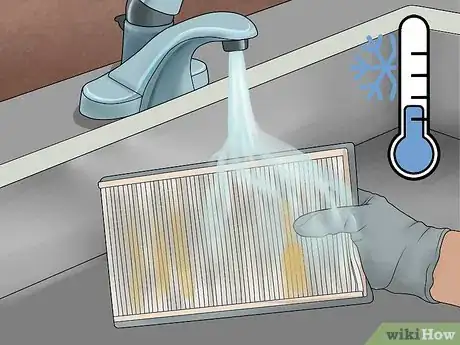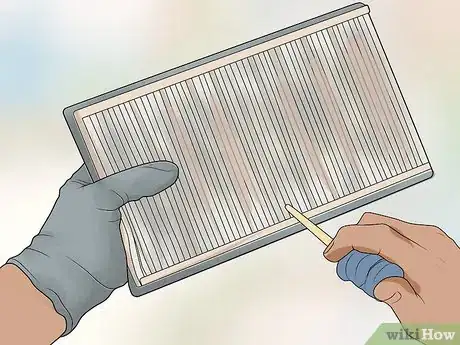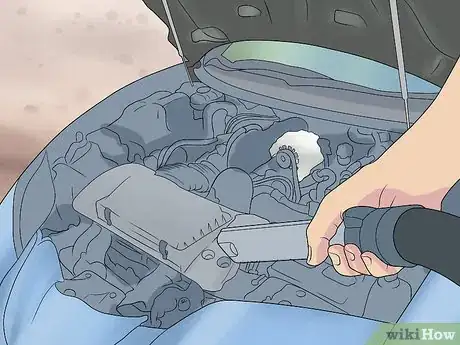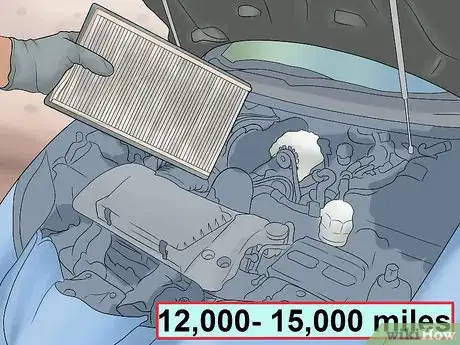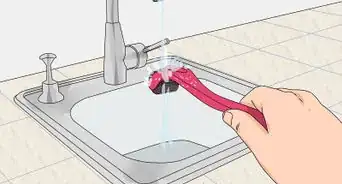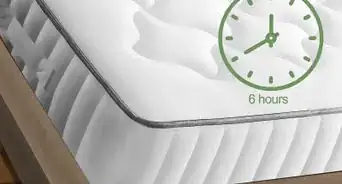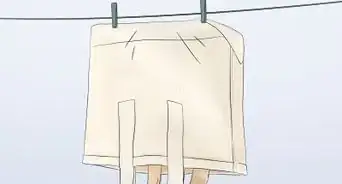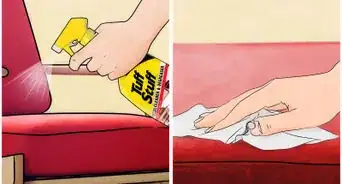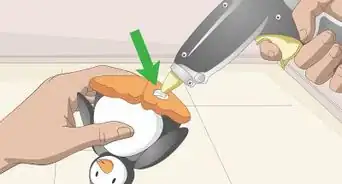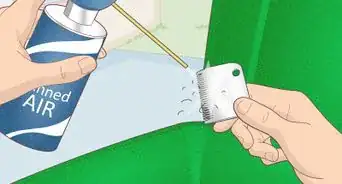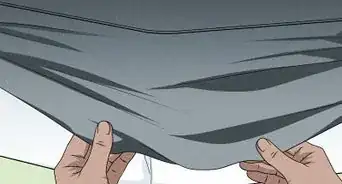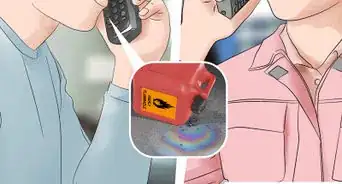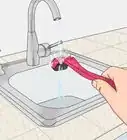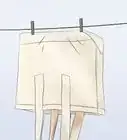This article was co-authored by Victor Belavus. Victor Belavus is an Air Conditioning Specialist and the Owner of 212 HVAC, an air condition repair and installation company based in Brooklyn, New York. In addition to HVAC and air conditioning units, Victor also specializes in furnace repair and air duct cleaning. He has over 10 years of experience working with HVAC systems.
This article has been viewed 110,952 times.
You can clean your car or home air filters yourself, but be aware that hiring a professional to replace it for you lessens the possibility of error. Make sure the filter is compatible with cleaning; for instance, disposable air filters should be replaced, not cleaned, whereas permanent filters may be washable. Vacuuming is the quickest way to wash a reusable filter, although heavy grime may require washing.
Steps
Cleaning a Home Air Filter
-
1Turn the system off before touching the filter.[1] Clean the area around the vent with a broom or vacuum before opening the vent. Open the screw(s) or latch and swing open the vent.[2] Vacuum the encasement area, then take out the air filter.[3]
- If the system isn’t turned off first, it will suck in debris during the cleaning process.
- Use a step ladder if the vent is up on the ceiling or a high wall.
-
2Remove excess dirt. Brush dirt off the filter into a trash container outside. Connect a hose attachment to your vacuum cleaner. Vacuum dust and debris from the filter with an upholstery attachment on the filter’s front, back and sides.[4]
- Vacuum the filter outside, if possible, to avoid stirring up dust in the home.
Advertisement -
3
-
4Wash off heavy grime with a soap solution, if needed. If a simple rinse isn’t doing the job, you can soak your filter in a soap solution. Add a drop of mild liquid dish soap to two cups of warm water in a bowl. Stir the solution. Wet a cloth in the solution and wash both sides of your filter. Rinse the filter with water, and let it dry completely.[8]
- After the final rinse, shake off any excess water before setting the filter out to dry.
- You may want to wash your filter with a soap solution if it’s been exposed to grease, smoke or pet hair.
-
5Dry the filter thoroughly. Pat the filter dry with paper towels. Leave the filter outside so it can air-dry. Make sure that the filter is completely dry before re-installing it.[9]
- Neglecting to let the filter dry completely can cause mold growth, which can spread spores throughout your home through the HVAC.
-
6Replace the filter. Place the filter back in its housing. Ensure that the airflow is facing in the proper direction. Close the vent, and secure any screws or latches.[10]
- The filter should sit snugly, without appearing too small or warped. Make sure there are no gaps.
Cleaning a Car Air Filter
-
1Remove the filter. Open the hood of your car. If you can’t locate the filter, check the physical or online vehicle manual. Alternately, you can ask a mechanic the next time your vehicle is serviced. Open the canister (usually secured with wing nuts or clamps). Pull the filter out.
- The air filter’s housing should be on top of the engine, in a round or rectangular box.
-
2Vacuum a dry filter. Connect a hose attachment to your vacuum cleaner. Vacuum the filter for about a minute on each side. Look at the filter under a bright light, and vacuum any spots you may have missed.
- Vacuuming is faster and safer than washing the filter.
-
3Wash a dry filter, if desired. Fill a bucket with a soap and water solution. Place the filter in the bucket and swirl it around. Take the filter back out and shake off excess liquid. Rinse the filter gently under running water. Put the filter on a towel and allow it to dry completely.
- Don’t put the filter back when it’s still wet! This can damage the vehicle’s engine.
- Washing can get your filter cleaner than vacuuming alone, but is riskier and more time-consuming.
-
4Cleanse an oiled filter. Tap the filter to shake off dust and dirt. Apply a cleaning solution (specifically for oiled filters) liberally to the outside, then inside of the filter. Make sure the filter is completely saturated. Leave it in a sink or basin for ten minutes. Rinse it with cool water at a low pressure. Shake it off and allow the filter to completely dry.
- Don’t allow the cleanser to dry on the filter; let it sit only for ten minutes.
- Rinse the filter by moving it up and down under the stream of water.
- After the rinse, the filter should be dry in about fifteen minutes; but if it isn’t thoroughly dry, allow it to sit longer.
- If you’re short on time, you can use a hair dryer or small fan on moderate heat to speed up the drying process, after the rinse stage only.
-
5Re-oil a filter, if applicable. Apply air filter oil evenly to the filter. Coat the filter thoroughly with a thin layer. Wipe off any excess oil from the cap and bottom lip of the filter. Allow the filter to sit for twenty minutes to absorb the oil.
-
6Clean out the canister. Vacuum dust and dirt from the filter housing, using a hose attachment. Alternately, you can use a soft cloth or paper towel. Just make sure the canister is completely dry and free of debris before replacing the filter.
- Moisture and debris can cause damage to the engine.
-
7Replace the filter. Return the filter to its housing. Secure any locks or clamps that hold it in place. These will be the same ones you undid when you removed the filter.
Evaluating Whether to Clean or Replace Filters
-
1Replace disposable air filters. A cleanable air filter is advertised as “washable,” “permanent,” and/or “reusable.” Don’t wash paper or otherwise disposable air filters. Avoid vacuuming them as well.[11]
- Washing disposable air filters can actually clog them, as well as cause mold.
- Disposable filters can tear under the pressure of vacuuming or compressed air. At a low pressure, this may work temporarily, but it’s not a long-term solution.
-
2Clean or replace your car air filter regularly. Clean or change your filter every 12,000 to 15,000 miles, or more often if you travel on dusty roads or in polluted areas.[12] Examine your air filter under a bright light. Clean or change the filter if it’s darkened or clogged with debris.
- Disposable filters should be replaced, whereas permanent filters can be vacuumed or washed.
- If you don’t change your air filter as needed, you may notice a decrease in your gas mileage, ignition problems, or fouled spark plugs.
-
3Clean or replace your home air filter routinely. Clean or change your filter every three months, and more frequently in-season. Clean or change the furnace filter monthly during the heating season.[13] Clean or replace your central air filter every month or two in the cooling season.[14]
- If your filter is disposable, replace it. If it’s reusable, you can vacuum or wash it.
- More frequent changing is needed if your filter is exposed to a lot of dust or pet hair.
- Failing to clean your air filters in the home can cause HVAC failure or even fire.
Expert Q&A
Did you know you can get expert answers for this article?
Unlock expert answers by supporting wikiHow
-
QuestionShould I use a reusable air filter for an air conditioner?
 Victor BelavusVictor Belavus is an Air Conditioning Specialist and the Owner of 212 HVAC, an air condition repair and installation company based in Brooklyn, New York. In addition to HVAC and air conditioning units, Victor also specializes in furnace repair and air duct cleaning. He has over 10 years of experience working with HVAC systems.
Victor BelavusVictor Belavus is an Air Conditioning Specialist and the Owner of 212 HVAC, an air condition repair and installation company based in Brooklyn, New York. In addition to HVAC and air conditioning units, Victor also specializes in furnace repair and air duct cleaning. He has over 10 years of experience working with HVAC systems.
Air Conditioning Specialist
References
- ↑ http://www.partselect.com/JustForFun/Air-Conditioning-Filters-Guide.aspx
- ↑ http://www.ebay.com/gds/How-to-Clean-Your-Home-Air-Filter-/10000000177632766/g.html
- ↑ http://www.housecleaningcentral.com/en/cleaning-tips/tip/cleaning-air-filters.html
- ↑ http://www.housecleaningcentral.com/en/cleaning-tips/tip/cleaning-air-filters.html
- ↑ http://www.partselect.com/JustForFun/Air-Conditioning-Filters-Guide.aspx
- ↑ http://www.ebay.com/gds/How-to-Clean-Your-Home-Air-Filter-/10000000177632766/g.html
- ↑ http://www.housecleaningcentral.com/en/cleaning-tips/tip/cleaning-air-filters.html
- ↑ http://www.housecleaningcentral.com/en/cleaning-tips/tip/cleaning-air-filters.html
- ↑ http://www.ebay.com/gds/How-to-Clean-Your-Home-Air-Filter-/10000000177632766/g.html
- ↑ http://www.ebay.com/gds/How-to-Clean-Your-Home-Air-Filter-/10000000177632766/g.html
- ↑ Victor Belavus. Air Conditioning Specialist. Expert Interview. 6 May 2020.
- ↑ http://procarmechanics.com/clean-air-filters-help-gas-mileage/
- ↑ http://www.ebay.com/gds/How-to-Clean-Your-Home-Air-Filter-/10000000177632766/g.html
- ↑ https://energy.gov/energysaver/maintaining-your-air-conditioner
About This Article
Before cleaning a home air filter, turn off the air filter system so the debris doesn’t get sucked back into the system during the cleaning process. Then, open the air vent and use the hose attachment on your vacuum to remove any dust. Next, remove the filter and vacuum the dust and debris from the front, back, and sides. Afterwards, rinse the filter under running water to remove any remaining dust and debris. Finally, pat it dry with paper towels and let it finish air drying before reinstalling it, since moisture on your filter can lead to mold growth. To learn more, including how to tell whether you should clean or replace your filter, read on!

